|
Ripsxit
As dawn breaks on the twilight of my career, I realise that it may well be time for me to leave the hallowed institution that is Getting Away With Murder, which is affectionately known as “GAWM” or, in Yorkshire, as ‘gawmless’.
It is, after all, more than ten years now since GAWM moved in the January transfer window for an undisclosed fee from Sherlock magazine to Shots and 124 instalments and over half a million words later, it may be time to rethink the relationship between GAWM and the crime fiction community.
There have been disappointments along the way, I must admit. Many of the innovations proposed by GAWM have sadly not come to pass; for example my call for a 90-day moratorium on the publication of any crime novel with ‘Girl’ in the title until we can figure out just what’s going on, or my plan for a wall to be built across Schleswig-Holstein to prevent illegal Scandi-crime novels crossing into Europe.
And whilst there have been many high points – notably the establishment of the annual Chianti Crime Festival and the sadly posthumous recognition achieved for the career of Scandicrime diva Nisse Ektorp – there have been setbacks as the imperial forces of crime fiction publishing have struck back.
Possibly it is time to call it a day, but such a momentous decision cannot be taken lightly. Perhaps we should ask the people, because that usually works, doesn’t it?
Consequently there will be a referendum where the single question will be: Should GAWM remain or leave and readers are asked to vote either REMAIN or LEAVE, IN THE NAME OF GOD GO, although simply LEAVE will do. Voting is open now and closes on 1st April and can be done by using the Contact Us box on the Shots homepage or by emailing shotseditor@yahoo.co.uk and putting REMAIN or LEAVE in the Subject box.
Party Time
My spirits were lifted and my faith in human nature restored by receiving invitations to not one but two publishers’ parties last month.
The first was to launch Pan Macmillan’s Thin Blue Spine initiative to promote their crime fiction list (www.thinbluespine.com) and was a splendid event even if held in and among some rather gruesome exhibits at the Hunterian Museum of the Royal College of Surgeon, including this collection of squeamish hacks delicately avoiding eye contact with any of the medical specimens on show in the display cases:

It was also good to see the always-dapper Chris Simms, editor of Crimesquad.com, back on the London scene and, as always, a wow with the ladies.
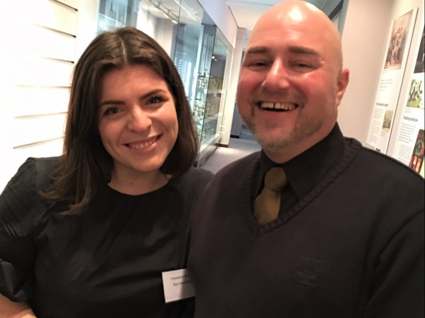 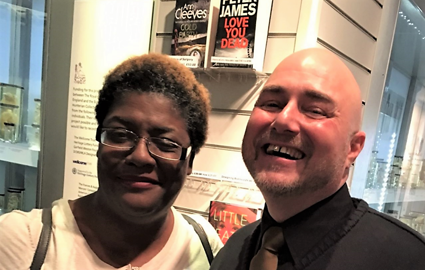
But the main purpose of the party was, of course, to meet Pan Macmillan crime writers and take the opportunity to congratulate one of their star authors, Ann Cleeves, on her recent award of the Crime Writers’ Association’s Diamond Dagger.
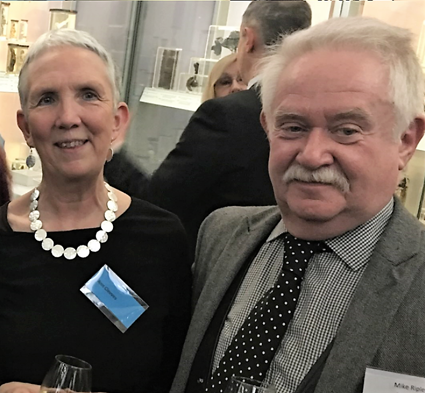
It was a delight to meet writers I did not know, such as Michelle Davies – whose new novel Wrong Place has a police Family Liaison Officer as the central character – and Mandasue Heller (latest bestseller Run) who assured me that she was an accomplished and enthusiastic jazz singer. A quick check on YouTube proved that she was telling nothing but the truth.
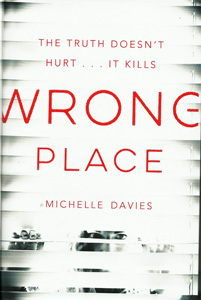 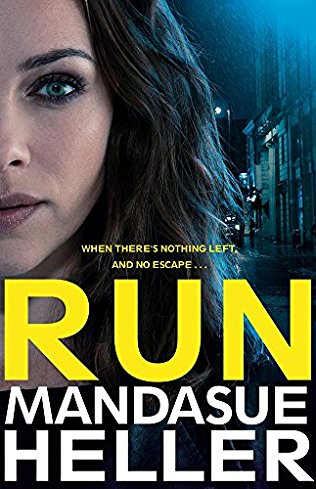
And there was a splendid party in the heart of London’s theatre district (near The Windmill, which I am told is an entertainment venue) to mark the launch of Raven Books, an imprint of Bloomsbury which aims to publish “for those who like their books with a touch of the dark side”. The event attracted the great and good of the crime fiction world and also a large number of literary agents, among them David Headley of Goldsboro Books, who as well as being an agent also holds the title of being London’s Most Fashionable Bookseller.

I believe that the first tranche of Raven Books will be published next year, but I have already heard of one which has piqued my interest, The Seven Deaths of Evelyn Hardcastle by Stuart Turton, whom it was a pleasure to meet and I even allowed him to practise his skills as a ventriloquist on me.
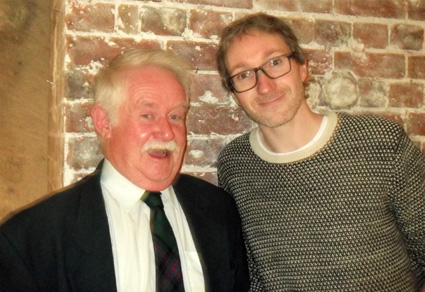
In a summation worthy of an experienced blurb-writer, Stuart summed up The Seven Deaths of Evelyn Hardcastle as “Ground Hog Day meets Agatha Christie” but, intriguingly, would not be pressed further.
Girls, Girls, Girls
If I thought I was getting paranoid about the number of crime novels with the word ‘Girl’ in the title, my fears have been put into perspective by American blogger Steve Donoghue who has identified no less than 41 titles as his ‘Worst Books of 2016 – Fiction’.
To be fair, not all of them are crime fiction, though most are, showing that the ‘Girl’ cachet has spread across the romance, horror, fantasy and Young Adult genres rather like a living, moving dragon tattoo. Steve Donoghue does not pass comment on individual titles, simply shows their covers, including The Girl in the Red Coat, The Girl in the Blue Coat, Dawn Girl, The Fire Proof Girl, The Girl in the Ice, Girl Underwater, the Girl who Cried Murder, The Girl who Cried Wolf and The Girl Who Lied, listing them all as the #1 worst fiction of 2016.
I have to take issue with Mr Donoghue on one title, as Martin Cruz Smith’s wartime thriller The Girl from Venice, a novel I greatly enjoyed, is included in his hit list. Perhaps one should not be so quick to judge a book by its title – or having an identikit cover showing ‘girl walking away’ – though I have to admit it often saves a lot of time.

I hear that the Swedish title of the fifth volume of Steig Larsson’s ‘Millennium Trilogy’ as continued by David Lagercrantz has been announced – naturally enough in Sweden. It translates, I believe, as The Man Who Chased His Shadow, but the official English title when the book is published in the UK in September by Maclehose has yet to be announced.
I wonder what odds I can get on their being a ‘Girl’ in the title?
Double Whammies
There is always a faint tingling of the spine when, having read a book I have been meaning to get around to for ages, I immediately pick up a newly-published one which covers similar territory and themes. I am not, I hasten to say, implying any form of plagiarism, merely flagging up a curious coincidence, in fact the double coincidence which I experienced last month.
Far better known as an actor than a writer, (Sir) Anthony Quayle wrote two thrillers based on his personal wartime experiences: Eight Hours From England (1945), which drew on his time as an undercover SOE (Special Operations Executive) agent in Albania in 1942, and On Such A Night (1947) which was clearly inspired by his service as an Aide to the Governor of Gibraltar in 1943. By the time both books came out in paperback in the 1950s, Anthony Quayle was established as both a respected theatrical actor (and actor-manager) and movie star. He wrote no more thrillers, though he did go on to star in some important wartime thriller films, notably Ice Cold in Alex, The Guns of Navarone, Operation Crossbow and The Eagle Has Landed.
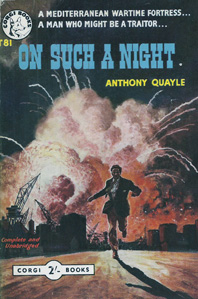 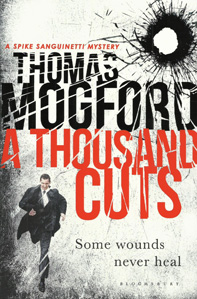
On Such A Night is set on an ‘island fortress’ in the Mediterranean called Pelleria which bears a remarkable resemblance to Gibraltar during WWII (even down to the same street names) and at one point involves an explosion in the naval dockyards there.
Having finally got around to reading it, I then turned to the new novel by Thomas Mogford, A Thousand Cuts, out now from Bloomsbury, which is set on Gibraltar in the present day but which has a back story dating to the wartime period and involves and explosion in a naval dockyard.
There the similarities end (Mogford is a much better writer for one thing, though probably a worse actor), and I have always had a sneaking admiration for Spike Sanguinetti, Mogford’s lawyer hero who is Gibraltar-based but familiar with all the islands and ports washed by the Mediterranean. A Thousand Cuts begins as a court room mystery, with Spike defending a particularly unpleasant character, and develops into an intriguing thriller centred on the fate of Spanish spy executed by the British in 1940 and as a bonus we get the ongoing story of Spike’s family and a wonderful sense of life on ‘the Rock’ which can be both an island paradise and the most claustrophobic example of a Little England. The whole series is highly recommended and this latest shows Mogford at his cleverest.
And then I find myself reading two books which both prominently feature Agatha Christie.
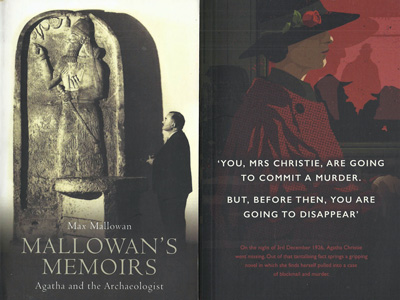
Mallowan’s Memoirs, first published in 1977 are, as you should have guessed, the memoirs of archaeologist Max Mallowan who was to become Dame Agatha’s second husband. The book is primarily – and fascinatingly – concerned with archaeological excavations in northern Iraq before and after the war but there is also a very interesting section on Mallowan’s war service. Initially treated with suspicion as his father was an Austrian by birth, he resorted to taking ‘comic satisfaction’ from a brief spell in the Home Guard protecting the coast around Brixham and Torquay before managing to join the RAF and serve in North Africa for three years.
Yet I suspect most readers were attracted to Mallowan’s Memoirs (reissued by Harper Collins in 2010) by the section on Agatha Christie, and indeed the book is subtitled Agatha and the Archaeologist, though it contains far more on archaeology than on Agatha. However, next on my reading list was all Agatha but not the Agatha of detective fiction, but rather the Agatha in detective fiction.
Following the trail blazed by the talented Nicola Upson with her novels featuring crime writer Josephine Tey as a central character in a mystery story, Andrew Wilson now puts Agatha Christie front and centre in A Talent For Murder, which will be published by Simon & Schuster in May.
Not only is Agatha the first-person narrator, but the story revolves around the real-life mystery of Agatha’s famous ‘disappearance’ in December 1926. The story of those missing eleven days, until Agatha turned up in a Harrogate hotel registered under a false name, was first told to me by Jared Cade in a bar (naturally) during one of the infamous Shots On The Page conventions in Nottingham in the early 1990s, and he went on to write a respected but controversial book on the subject.
After a domestic row, Agatha’s car was found abandoned at Newlands Corner in Surrey, sparking a nationwide search and massive press coverage. (It is a lesser known fact that one of the volunteers in the Surrey search party was fellow crime writer Dorothy L. Sayers). The reason for her disappearance has remained a mystery and so Andrew Wilson has stepped in to provide a fictional one and in true Christie tradition, there is a very shady doctor at the heart of things.
Andrew Wilson, I believe, will be talking about A Talent For Murder (not to be confused with the late Robert Barnard’s superb critical appreciation of Christie’s work, A Talent To Deceive) at this year’s Crimefest and more novels starring, rather than by, Agatha Christie are promised. Andrew Williams may be on to something here, as he has already written biographies of Harold Robbins and Patricia Highsmith. Now there are two writers who might make interesting fictional detectives. Or perhaps not.
(Murder on) The Riviera Express
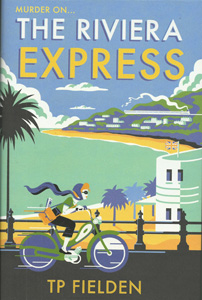 I thought I had stumbled on a third Agatha Christie connection when I received a copy of The Riviera Express [Harper Collins] by T.P. Fielden and automatically added the words “Murder On” to the title. The Riviera Express is, however, a newspaper not a train, although it is that as well, and the setting is the Devonshire ‘English Riviera’ in the 1950’s, which was certainly Dame Agatha’s stomping ground. I thought I had stumbled on a third Agatha Christie connection when I received a copy of The Riviera Express [Harper Collins] by T.P. Fielden and automatically added the words “Murder On” to the title. The Riviera Express is, however, a newspaper not a train, although it is that as well, and the setting is the Devonshire ‘English Riviera’ in the 1950’s, which was certainly Dame Agatha’s stomping ground.
And the novel – the first in a series I’m told – has a heroine Agatha Christie would certainly approve of: Miss Judy Dimont, a fortysomething reporter with the fastest shorthand in the West Country and a roving reporter thanks to her trusty moped called Herbert. (Whoever thought crime writers would name their central character’s mode of transport?)
Naturally it is only a matter of time before the sunny coastal town of Temple Regis has a murder or two and who should be on hand to solve the case but the redoubtable Miss Dimont?
Another Sort of Double Whammy
I am so old that I can remember when an editor from the then fledgling imprint Orion pleaded with me to try a new, unknown, American crime writer as it was ‘so difficult to sell Americans here’. Incredible as it sounds, it really was back then and had it not been for the opening of the infamous Murder One bookshop in 1988 I would not have discovered James Ellroy, Charles Willeford and Charles Williams, among others. So I had some sympathy for that editor and agreed to give this new guy, Michael Connelly and a book called The Concrete Blonde, a chance.

Photo: Mark Delong
More than two decades later, Michael Connelly needs no introduction from me, but I may be of use to his many fans in this country by spreading the news that he will have two new titles out here this year. The Late Show, coming in July (from Orion, of course) introduces a new central character, night shift detective Renée Ballard, but die-hard fans need not despair as a new (as yet untitled) Harry Bosch novel will follow this Autumn.
|
|
My Favourite Assassins
For purely selfish reasons, I am currently reading The Venetian Game by Philip Gwynne Jones, published this month by Constable.

It is, I think, the first crime novel by Welshman Philip Gwynne Jones, who now lives in Venice, and it features as hero Nathan Sutherland, a translator who doubles as the Honorary (i.e. unpaid) English Consul with an office in the Calle Dei Assassini - the street of the assassins.
Now I know this street, or being Venice, alley, and the local legend behind its name and why it was the first alley made to have street-lights (torches) by civic ordnance. I am also an enthusiastic frequenter of the marvellous restaurant there, the Osteria Ai Assassini.
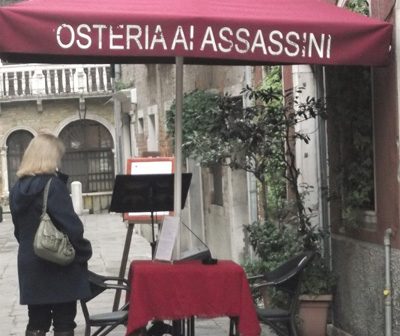

However, I don’t for the life of me remember seeing any sign of an English Consulate there, but I will read on in the hope that our hero will find himself hungry and in need of an excellent meal. Come to think of it, it might have been the excellent hospitality of the restaurant which made me miss the consulate…
Never Say Nero Again
For legal reasons I was unable to confer with my old chumLindsey Davis about her new novel The Third Nero at the recent party thrown by her publisher which attracted the great and good of the crime fiction community. I did hear, however, that jacket illustration was causing some concern and so naturally made some helpful suggestions, all of which were swiftly discounted. Her new novel now features what looks to be a head of Janus, often referred to, rather sacrilegiously, as the patron saint of spies, but as The Third Nero is Lindsey’s (or Flavia Alba’s) impish take on spies and spy tradecraft in the Roman empire, I suppose it makes sense.
 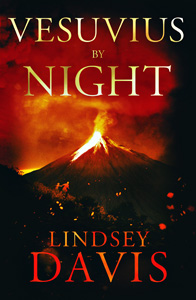
Lindsey also has a forthcoming ‘Kindle Single’ (whatever they are) titled Vesuvius By Night. Having been treated to an easy-to-read version of the text (i.e. typed) I can say that this is an intriguing novella set around the eruption of Vesuvius (spoiler alert: the volcano does erupt).
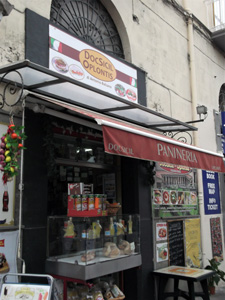
You can be assured that the historical background will be accurate as Lindsey knows the Pompeii, Oplontis and Herculaneum sites very well and is, later this year, the guest lecturer for an archaeological tour of the area organised by upmarket holiday company Andante. Eager to help as usual on matters archaeological, I have naturally recommended my favourite restaurant in Oplontis.
Yet Another Blast from the Past
Dean Street Press have once again dipped into that lonely well of forgotten authors from the ‘Golden Age’ of detective fiction reissued the three novels written by Elizabeth Gill (1901-1934) – no, me neither.

The Crime Coast, What Dread Hand? and Crime de Luxe were all first published between 1931 and 1933 and all feature an artist amateur sleuth called Benvenuto Brown.
Book(s) of the Month Club
Despite being blacklisted by at least three noted publishers of crime fiction (was it something I said?), I have been informed of 52 new mysteries to be published in March and April, roughly one every twenty-eight hours.
Being of great age and failing eyesight, I can only offer a rapid summary of some of the titles on offer.
My personal pick of the month is The Road To Ithaca by Ben Pastor [Bitter Lemon Press], which I mentioned last month and which I have reviewed for Shots.
Guy Bolton’s The Pictures [Point Blank] had me reaching for my battered fedora and trench coat as this is a wonderful evocation of Hollywood film noir, which is not surprising as it set in Hollywood in 1939. As its protagonist, The Pictures has an LAPD detective who is also a rather shady ‘fixer’ for the film studios, ensuring that the crimes and misdemeanours of Hollywood stars and starlets are covered up before their celluloid images are tarnished. The detective, Jonathan Craine, show his colours immediately when dealing with the gruesome torture and murder of a blonde, white female (therefore the killer must be a negro housebreaker…) but when one of the producers of The Wizard of Oz is found dead, things for Craine (and Louis B. Mayer) get complicated. Film buffs as well as crime buffs will love it.
The police procedurals featuring detective Maeve Kerrigan (now a Detective Sergeant) are growing the reputation of author Jane Casey and Let The Dead Speak, from Harper Collins, will only add to that reputation. This is a solid, top quality crime novel with a predominantly female cast of police investigators, although a far more orderly and law-abiding team than the anarchic one featured in the excellent TV series No Offence, and it comes with an intelligent dissection of secrets and lies in suburban London.
Bay Of Martyrs from Scottish publisher Freight Books could, I suppose, be described as a piece of ‘Tartan Noir’ but set in a better climate. Its authors are the prolific Tony Black (14 novels, five collections of short stories and seven novellas since 2008) and Australian journalist Matt Neal and launches a new series featuring investigative reporter Clay Moloney whose ‘beat’ is the sunny south coast of Australia, though presumably not all of it.
Although I have not yet seen it, I hear much of French crime writer Antonin Varenne’s historical blockbuster Retribution Road [MacLehose Press] which is described as ‘a war novel, serial-killer thriller and Western’ all in one, the setting being Burma, London and America in 1858.
Book(s) of the Next Month’s Club
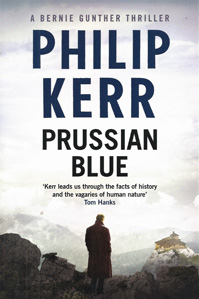
April is certainly the cruellest month this year (so far) for readers forced to choose between titles from some of crime fiction’s big-hitters apart from the new Roman mystery by Lindsey Davis (see above) and a new Bernie Gunther thriller, Prussian Blue, which I have mentioned in a previous column and which has somehow already received 15 very positive reviews on Amazon two months before publication.
There are strong Scottish offerings to enjoy in these final months before a post-Brexit Scotland goes totally independent and Hadrian’s Wall gets rebuilt. Chris Brookmyre revives his cynical, smart-mouthed journalist hero Jack Parlabane for Want You Gone [Little Brown], a character I have admired for twenty years in those distant days when the author was called Christopher. But also watch out for Ed’s Dead by Russel D. McLean [Contraband], one of Scotland’s most skilled noiristas, with a book which will appeal to booksellers everywhere, especially homicidal ones…
From Ireland, but set in New England, comes A Game of Ghosts by John Connolly [Hodder], the fifteenth novel to feature Charlie Parker, a detective who attracts the spooky and the supernatural and takes them in his stride with the help of his violent entourage of sidekicks. If you are already a fan of Connolly’s blend of weird crime stories (in the best possible sense) then you’ll know what to expect and won’t be disappointed.
Peter Morfoot and Captain Paul Darac of the Brigade Criminelle operating in old town Nice are both new names to me, but not for long. Fatal Music [Titan Books] is a thoroughly satisfying novel, the second in the series, which sees jazz-loving detective Darac on a case which begins with the very grisly murder of an elderly lady in a hot tub. Morfoot brilliantly captures the sights, smells and attitudes of southern France as well as giving us an engaging hero – but then anyone who has Django Reinhardt as a hero is alright in my book.
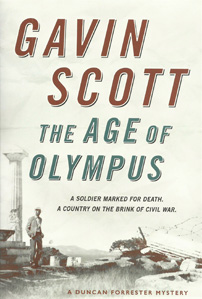 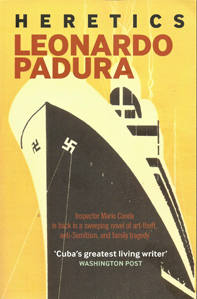
From the sunny French Riviera to sunny Greece for The Age of Olympus by Gavin Scott [Titan Books] but hardly sunnier times as the setting is the immediate post-war period and the country is on the brink of civil war. Into this potentially explosive situation is pitched Oxford academic and former SOE agent Duncan Forrester, ostensibly on a mission torecover an archaeological artefact from Crete, discovered during the war. There are cameos for Patrick Leigh Fermor, whose exploits behind enemy lines in Crete are well-known, and the cartoonist Osbert Lancaster, who was a Foreign Office press attaché in Greece at this time.
Finally, to even sunnier climes, Havana, for Leonardo Padura’s positively epic Heretics [Bitter Lemon Press] and the return of policeman Mario Conde of ‘Havana Quartet’ fame. Conde and Havana are the joint protagonists of Padura’s crime writing, both have seen better days and both experience joyous highs and depressive lows. Heretics revolves around a missing Rembrandt belonging to a Jewish family who had attempted to escape from Nazi Germany in 1939 St Louis, on what has since become known as the ‘voyage of the damned.’
Last Word
Radio journalist and podcaster Tim Haigh has long been a fan of crime fiction. In fact I first met him when he was covering the Diamond Jubilee party of Collins Crime Club and podcasts (whatever they are) of that infamous LBC show are still available. Hearing it again, a quarter of a century on, the cut-glass RP accents of most of the interviewees still ring out in clear contrast to the soft wistfulness of Reginald Hill and my own blunt north country vowels.
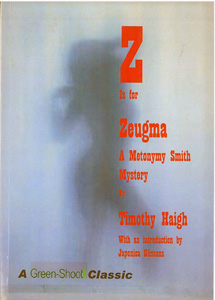
Finally, Tim Haigh has got his own back on crime fiction with Z is for Zeugma [Green Shoot Books] described as ‘A Metonymy Smith Mystery’ and Sue Grafton, for one, is probably considering legal action. It is a novella of written and visual jokes, garlicky puns and total silliness. It proves that Tim Haigh knows an awful lot of words, though not necessarily in the right order.
Pip! Pip!
And don’t forget to vote,
The Ripster
|